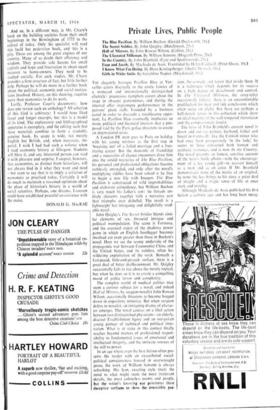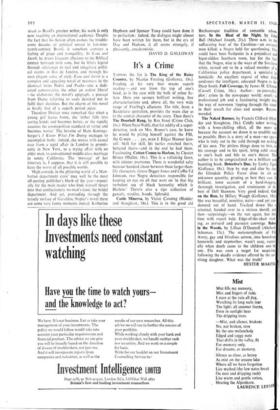Private Lives, Public People
The Blue Pavilion. By William Buchan. (Gerald Duckworth, 21s.) The Secret Soldier. By John Quigley. (Hutchinson, 25s.) Hall of Mirrors. By John Rowan Wilson. (Collins, 21s.) The Ulcerated Milkman. By William Sansom. (Hogarth Press. 21s.)
In the Country. By John Branfield. (Eyre and Spottiswoode, 25s.)
Esau and Jacob. By Machado de Assis. Translated by Helen Caldwell. (Peter Owen, 30s.)
I Know What l'm Doing. By Hans Koningsberger. (Andri.' Deutsch, 18s.) Girls in White Satin. By Geraldine Napier. (Macdonald, Its.)
THE elegantly baroque Pavillon Bleu at Ver- sailles caters discreetly to the erotic fancies of a moneyed and internationally distinguished clientele: precocious nymphets cavort about the stage in obscene pantomimes, and during the interval offer impromptu performances in the patrons' plush stalls. Founded by a business cartel in order to discredit a troublesome oppo- nent, Le Pavillon Bleu eventually implicates so many political and financial interests that a pro- posed raid by the Paris police threatens to create an international crisis.
A London PR man goes to Paris on holiday with his young mistress as the first step in 'breaking out' of a failed marriage and a frus- trating career. But the demands of friendship and a succession of chance encounters draw him into the sordid mysteries of The Blue Pavilion; his personal and professional obligations become ruthlessly entangled, and only after the novel's multiplying riddles have been solved is he free to begin a new life with Imogen. The Blue Pavilion is constructed of NN i 1J improbabilities and elaborate coincidence, but William Buchan is very much his father's son: he threads un- likely elements together with a narrative zest that triumphs over disbelief. The result is a lightweight but intriguing and delightfully read- able novel.
John Quigley's The Secret Soldier blends simi- lar elements of sex, financial intrigue and political manipulation. The scene is Formosa, and the eventual stakes of the shadowy power game in which an English bootlegger becomes involved are even greater than those in Buchan's novel. Here we see the seamy underside of the propaganda war between Communist China and the United States, and its ruthless, often be- wildering exploitation of the weak. Beneath a fast-paced, hide-and-go-seek surface, there is a great deal of bitter disillusionment. Mr. Quigley occasionally fails to rise above the merely topical, but when he does so it is to create a compelling mood of gothic terror and complexity.
The complex world of medical politics may seem a curious subject for a novel, and indeed Hall of Mirrors, by surgeon-novelist John Rowan Wilson, occasionally threatens to become bogged down in expository minutiae. But when surgeon defers to novelist, an intriguing drama of charac- ter emerges. The novel centres on a libel action between two distinguished physicians—an elderly, discreet Establishment figure and an outspoken young pioneer of technical and political inno- vation. What is at stake in this contest finally reaches beyond matters of professional respon- sibility to fundamental issues of emotional and intellectual integrity, and the intricate sources of the will to power.
In an age where even the best fiction often pre- sents the reader with an exacerbated social- political consciousness housed in overwrought prose, the work of William Sansom is always refreshing. His lean, exacting style rivets the mind to what might seem the most irrelevant details, the most colourless events and people, but the writer's knowing eye penetrates these deceptive surfaces to show the irresistible pas- sion, the comedy and terror that reside there. It is a technique w hich depends for its success on a high degree of detachment and control. In The Ch.crated Milkman, the story-teller occasionally falters: there is an uncomfortable predilection for neat and tidy conclusions which often verge on cliché. But there are perhaps a half-dozen stories in this collection which show an ideal meeting of the well-tempered rhetorician and the compassionate ironist.
The hero of John Branfield's current novel is down and out (as painter, husband, father and lover) in Cornwall : like the Cornish miner who had once been prosperously 'in the lode,' he seems to have exhausted both human and aesthetic resources, and is now In the Country. The novel presents an honest, sensitive account of the hero's futile efforts—with the encourage- ment of a fey young girl—to reassert himself as a man and as an artist. If Mr. Branfield demonstrates none of the marks of an original, he none the less brings to his story a great deal of insight and a tragic sense of life at once stark and moving.
Although 'vlachado de Assis published his first fiction a century ago and has long been recog-
nised as Brazil's greatest writer, his work is only now reaching an international audience. Despite the fact that his fiction often evokes the trouble- some decades of political unrest in late-nine- teenth-century Brazil, it somehow conveys a feeling of grace and tranquillity. In Esau and Jacob, he draws frequent allusions to the Biblical contest between Min sons, but he filters legend through references to real and imaginary politi- cal events in Rio de Janeiro, and through his own elegant sense of style. Esau and Jacob is a complex and appealing novel of manners; in the identical twins Pedro and Paulo—one a dedi- cated conservative, the other an ardent liberal —he elaborates the novel's epigraph, a passage from Dante referring to souls destined not to fulfil their destinies. But the charm of this novel is finally that of a superb period piece.
Theodore Dreiser once remarked that when a young girl leaves home, she 'either falls into saving hands and becomes better, or she rapidly assumes the cosmopolitan standard of virtue and becomes worse.' The heroine of Hans Konings- berger's I Know What I'm Doing manages to accomplish both : indeed, she moves with casual ease from a tepid affair in London to promis- cuity in New York, to a trying affair with an older man, to conventional middle-class marriage in sunny California. The 'message' of her itinerary is, I suppose, that it is still possible to have the worst of all possible worlds.
'High comedy in the glittering world of a Man- hattan department store' may well be the most off-putting publisher's blurb of the year—especi- ally for the male reader who finds himself thrust into that confectionery no-man's-land, the bridal department. And yet, protruding through the treacly surface of Geraldine Napier's novel there are some very funny moments indeed. Katherine Hepburn and Spencer Tracy could have done it to perfection : indeed, the dialogue might almost have been written for them, but in the era of Day and Hudson, it all seems strangely, if pleasantly, anachronistic.
DAVID D. GALLOWAY







































 Previous page
Previous page